
ICCROM_ICS10_JukkaFestchrift_en
.pdf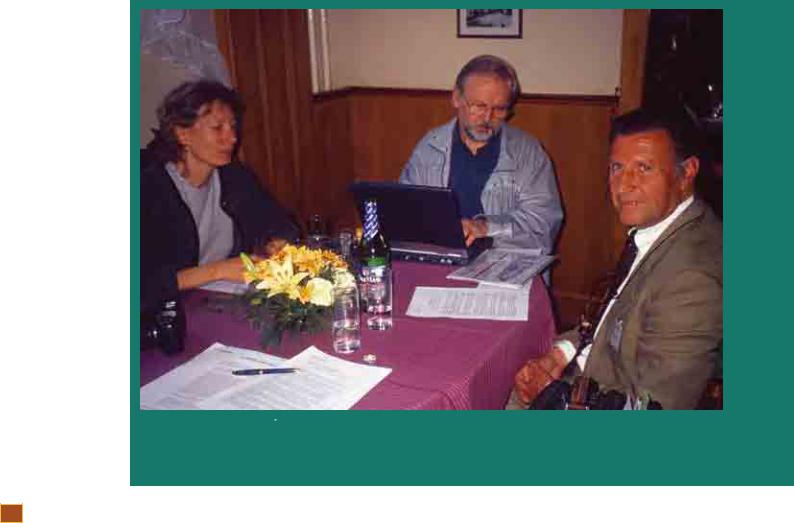
certification of materials suitable for built heritage conservation; for searching for necessary funding and resources required for the establishment of a training centre, possibly to be located in Banská Štiavnica, for mid-level craftspersons and technicians; for encouraging property owners to request the support of qualified craftspersons and conservation architects when undertaking work on heritage properties; for building an information and documentation centre to support training activities; for giving special attention to the monitoring of the condition of heritage sites and the effectiveness of the measures that have been taken; for introducing legislation that would force contractors to demonstrate the required standard and level of knowledge and capacity when undertaking projects in heritage conservation; and for ensuring that the legal framework and relevant building norms and standards support the implementation of good conservation practice. The Appeal also provided recommendations specifically for Banská Štiavnica.
In 2005 we organized a course and seminar on Lime and Lime Technologies in Built Heritage
Conservation with Hannes Weissenbach, craftsman and conservator of the Austrian Federal Office for Monuments (Bundesdenkmalamt - Restaurierungswerkstätten Baudenkmalpflege) of Kartause Mauerbach as principal resource person at both practical and theoretical levels. This time the main organizer was an NGO - Spolok Banskej Štiavnice ’91 - in collaboration with the Slovak National Board for Monuments and Sites Preservation, Austrian Federal Office for Monuments, the Town of Banská Štiavnica, the Faculty of Architecture and other institutions, with the main financial support coming from the Slovak Ministry of Culture.
During the 12-days course programme under the guidance of Hannes Weissenbach, a kiln was built in a publicly accessible place, lime was burnt, slaked, and then used in restoring the façade of the House of Crafts in Banská Štiavnica (Fig. 4). The interconnected seminar discussed challenges of preserving lime renders and the most recent knowledge about traditional lime technologies in present-day applications. In the framework of the seminar participants agreed upon
Fig. 3. Work on the draft Banská Stiavnica Appeal by Jukka Jokilehto, Gennaro Tampone (right) and the author (photo Michel Bonnette)
80 Conserving the authentic: essays in honour of Jukka Jokilehto
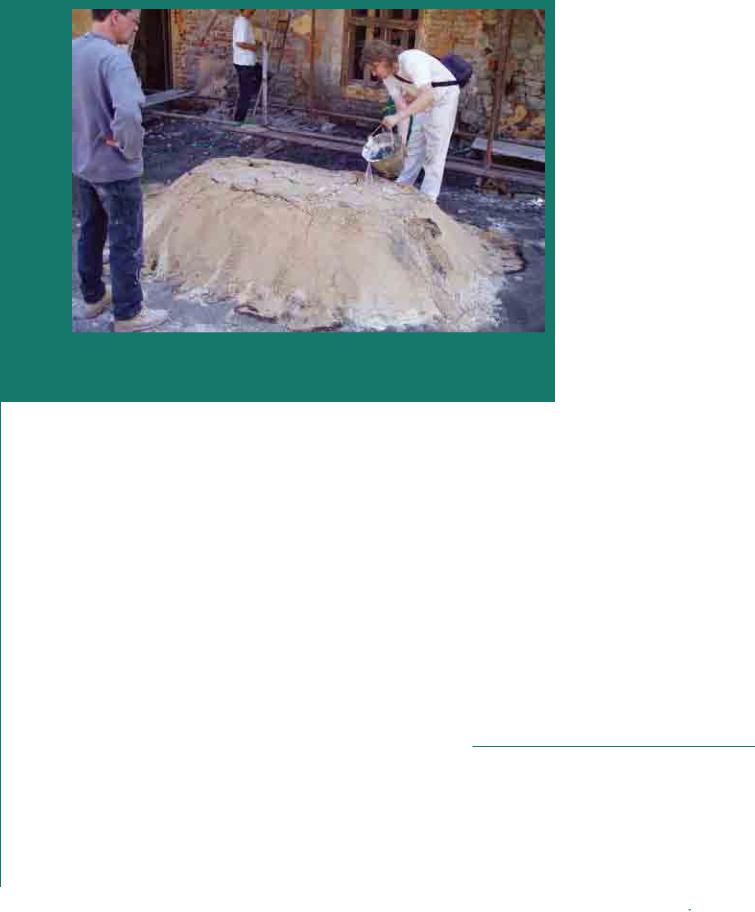
Recommendations prepared by our working group, with Hannes Weissenbach and Astrid Huber as key members. The Recommendations concerned the safeguarding and conservation of originals in the most appropriate and least invasive way; strengthening the practice of regular maintenance; strengthening research and broadening knowledge about these materials and technologies for the needs of conservation practice; the elaboration and publication of relevant methodical instructions; the introduction of a system of certified craftsmen and a system of scholarships for their specialization training; and the introduction of a system of life-long learning for craftsmen at national and regional levels (Fabian, Huber, Kohút, Michoinová, Vošková, Urland and Weissenbach 2005, 151).
In 2006 we focused on Doors and Windows in Built Heritage Conservation. The principal organizer was again the NGO Spolok Banskej Štiavnice ’91 in co-operation with the Faculty of Architecture, the Slovak National Board for Monuments and Sites Preservation,Schreinerei,Buildhauerei,Denkmalpflege Hubert Labisch, and Fensterhandwerker Johannes Mosler. This time the financial support was obtained through a grant from the Headley Trust. In eight days the principal lecturers of the course and seminar, Hubert Labisch and Johannes Mosler, showed the methods of repair of windows (on examples from the 18th and 19th centuries) and of a Baroque wooden
door from the Calvary complex. There were 19 participants in the course and 46 in the seminar.
In 2007 the theme selected for the international colloquium was the Revitalization of the Banská Štiavnica Calvary. It was organized by the Faculty of Architecture of the Slovak University of Technology in Bratislava and financially supported by the Slovak Ministry of Culture and the Visegrad Fund. Also in this case we managed to come up with recommendations and a preliminary action plan for the safeguarding of this unique heritage complex.
Conclusion
The effort invested in this series of training programmes has already started yielding results, e.g. in the form of impact on better practice and interest in a more conscious
conservation and restoration of houses by their owners. The publications of the individual training sessions have been available in local bookshops, and they have helped some new owners to contact the authors about conservation approaches for their own properties. Several local craftsmen have improved their professional capacities. Public interest has been growing from one event to the next, volunteers have been involved in many ways, and the local authorities have started to be more collaborative and supportive.
The interest of the media, both press and television, in the training activities and public events, as well as the articles published by participants (Slovak and foreign) on their return home about their newly gained experiences, have helped to strengthen the overall impact.
References
Vošková, K., and Urland, A. (2002), Introduction, in
Banská Štiavnica workshop on materials, techniques and technologies in the built heritage conservation,
proceedings, (Pamiatkový úrad Slovenskej republiky), 7-8.
Huber, A., Fabian, P., Kohút, V., Michoinová, D., Vošková, K., Urland, A., and Weissenbach, H. (2005), Recommendations, in Banská Štiavnica training course and seminar on lime and lime technologies in built heritage conservation, proceedings, (Spolok Banskej Štiavnice ’91), 151.
12 The multiplier effect of ICCROM’s capacity-building: conservation training for professionals in Banská Stiavnica, Slovakia |
81 |
|
|

82 Conserving the authentic: essays in honour of Jukka Jokilehto

13
Historic reconstruction:
prospects for heritage preservation or metamorphoses of theory?
[ Natalia Dushkina ]
This contribution presents the theme of reconstruction that I first broached at its Helsinki meeting in 1995 at the request of the ICOMOS CIF committee. Thus, Dr.
Jukka Jokilehto − as the CIF President since 1993 and currently its Honorary President − became a father of my first public discussion on reconstruction and of my longstanding interest in this field. Since then this phenomenon has been analysed many times in recent decades with regard to the extraordinary Russian experience and the international context, including in papers given at the 11th and 15th ICOMOS General Assemblies in Sofia (1996) and X’ian (2005), at ICCROM (2002) and at the 10th International DOCOMOMO Conference (Rotterdam, 2008). Therefore it seems appropriate in this Festschrift publication to concentrate anew on the issue of historic reconstruction in its present forms and to sum up my observations of previous years.
Introductory overview
Looking at the heritage landscape of the 20th–21st centuries, it is possible to state that the quantity of reconstructed monuments is insignificant in comparison with the whole scope of conservation activities. However, reproduction of historical buildings claims to be one of the most intriguing aspects of modern
heritage practice. The clarity of numerous problems – scientific and cultural, political and ideological as well as ethical, always revealing in relation to the action of reproduction – gives this phenomenon an extreme position.
The destructions of two World Wars and of revolutions of the 20th century, especially the 1917 Russian Revolution with its global political and cultural cataclysms, brought about a new vision of the world. In combination with the destructive methods of the internationally widespread Modernism, several well-known peaks in the history of European reconstruction were passed. I dare to assume that today we are witnessing another outburst of this phenomenon, starting in the mid-1980s and still continuing, with every sign of expanding in the future. The recent blossoming of reconstruction activities has been provoked by deep changes within culture itself, as well as by the significant political metamorphoses of the late 20th century (strong globalisation, disintegration of the Soviet empire, reunification of Germany and political liberation of the Eastern European and Baltic countries, flourishing of the Asian development model marked by a global Chinese presence, etc.).
Most countries and their heritage are currently affected by different methods of historical reconstruction. Just to enumerate briefly several well-known examples, in Barcelona (the Liceo), Venice (La Fenice) and Drammen (in Norway) we come across
13 Historic reconstruction: prospects for heritage preservation or metamorphoses of theory? |
83 |
|
|
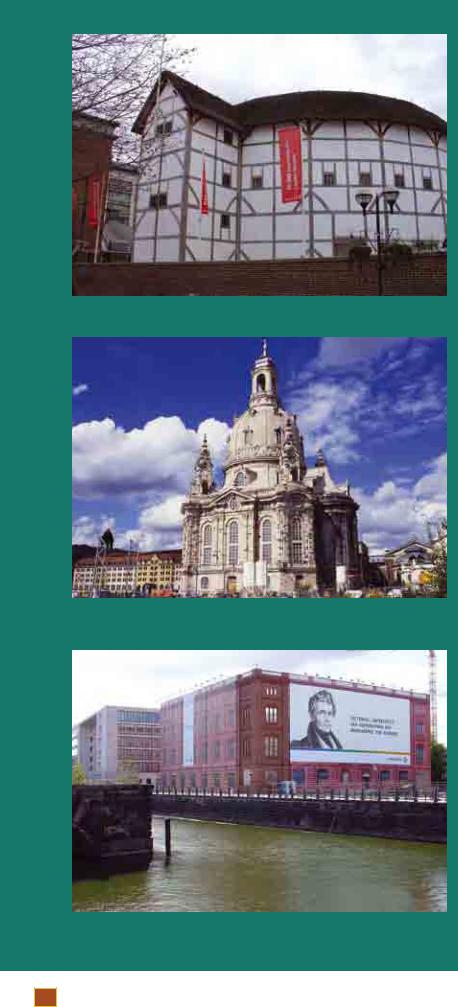
Fig. 1. Shakespeare’s Globe Theatre in London, UK. Destroyed by parliamentary edict in the 17th century and reconstructed in the 1990s (photo author, 2007)
Fig. 2. The Frauenkirche at Neumarkt in Dresden, Germany, built by George Bähr in 1726-1743, destroyed in 1945 and reconstructed from mid-1990s to 2005 within a World Heritage site (photo author, 2005)
Fig. 3. Promotion in favour of reconstruction project for the Bauakademie by Karl Friedrich Schinkel, 1831-1836, in central Berlin, Germany, destroyed in 1945 and totally dismantled in 1962 (photo author, 2007)
different approaches and methods in the reconstruction of theatres lost to fire (an action rightly justified in conservation theory). In London, on the contrary, we have witnessed an unprecedentedly bold reproduction of Shakespeare’s Globe Theatre (Fig. 1). It had never been seen in the 20th century, having been destroyed following a Parliamentary edict in the 17th century; however today there is an idea not only to duplicate other structures of that type in London, but also to build a Globe Theatre in Berlin (more revealing of its commercial impact in London than its cultural one).
In Germany one can identify a state programme for national revival achieved by means of historical reconstruction. Here, we mention first of all the ambitious replication of the Frauenkirche (Fig. 2) at Neumarkt in Dresden, a grandiose 18th century building by George Bähr that was destroyed in 1945. For decades the ruin itself had been a significant war memorial. The work was carried out with punctilious German attention to detail, with all of the authentic fragments that had survived being collected, identified and included in the new structure. The Neumarkt in Dresden itself currently presents further scope for reconstruction through imitating lost historical fabric. The practice recalls the post-war construction work in Warsaw’s Old Town rather than the modern urban capacities of the site.
After Dresden, dozens of reconstruction projects in Germany are under discussion, with striking examples in central Berlin, with plans to clone the famous Karl Friedrich Schinkel Bauakademie (Fig. 3) and to reconstruct (in line with the Act of the German Parliament of 2003) the 18th-century Königsschloss by Andreas Schlüter, both of them destroyed in the 1940s1960s. In the same cluster, the Kommandantehaus with imitation classical facades and totally new interior space was rebuilt in 2003. This case has been followed by the sensational proposal to reproduce the 16th-century Palais des Tuileries by Philibert Delorme in Paris, burned in 1871 and dismantled in 1883. In the Old City of Jerusalem a reinforced concrete reconstruction of the Hurva Synagogue, with work due to be completed in 2009, is intended to replace the commemorative arch at the site and ancient and mediaeval remains. A desire for a full visual “completeness” and “integrity” is often heard today with regard to the ancient sites of the Athenian Acropolis and Rome. It is symptomatic that, even at archaeological excavation sites for which reconstruction (except anastylosis) was a strict taboo for decades, the imitation of full-size prehistoric structures, including Neolithic monuments, is fast spreading for tourism purposes.
There are numerous examples of sound large-scale reconstruction projects proclaiming national identity in the post-Soviet countries: the large-scale concrete
84 Conserving the authentic: essays in honour of Jukka Jokilehto
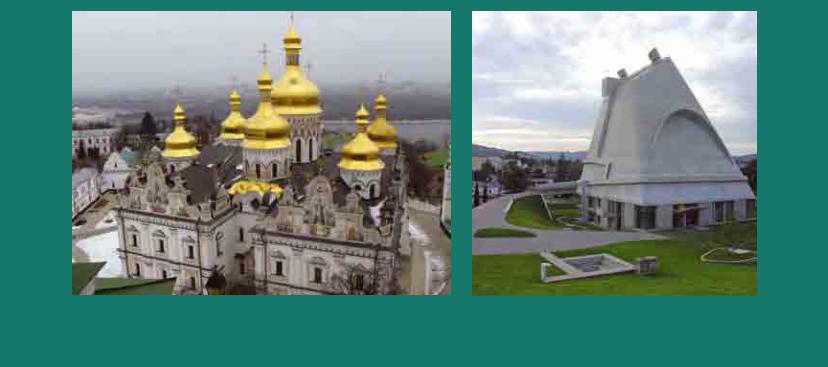
replicas of the 1990s in Kiev, Ukraine (the 13th century Church of Pirogoscha, and the 18th century St. Michael and Assumption Cathedrals of early medieval origin (Fig. 4) that had been destroyed in the 1930s-1940s); the copy of the 18th century City Hall in Minsk, Belarus, dismantled in 1857 and reinstituted in 2004; the mediaeval Schwarzhäuperhaus at the Rathaus square reconstructed for the 800th anniversary of Riga in Latvia; and the Royal Palace of Lithuania in Vilnius, completely demolished in 1801, and due to be reconstructed in 2009 following the decision of the Lithuanian Parliament; and so on.
Even young or recent heritage of the 20th century is the target of reconstruction efforts. Paradoxically, temporary and previously dismantled ephemeral exhibition pavilions represent a series of replicated structures turned into permanent ones (and often at different locations). Among them, such famous Modernist structures as L’Esprit Nouveau Pavilion (Le Corbusier, Paris, 1925) was copied in 1977 in Bologna. The German Pavilion by Mies van der Rohe (Barcelona, 1929) was rebuilt on the same site in 1986; while the Sonsbeek Pavilion by Aldo Van Eyke (Arnhem, 1966) was reconstructed in 2005 in Otterlo at the KröllerMüller Museum. Another Le Corbusier structure - the Philips Pavilion (Brussels, 1958) - is about to find its modern replication in the Netherlands. ICOMOS International supports the idea of reconstructing the Walter Gropius Master’s house (Bauhaus, Dessau, 1925-1926). Simultaneously, unfinished or non-built projects start to be subject to final completion, with
the Church of Saint-Pierre (Fig. 5) in Firminy-Vert (Le Corbusier, 1960-1965) as the most illustrative case of the last decade. This newly built structure of 2006 has even been nominated by France to the World Heritage List within the Le Corbusier cluster nomination in 2008. As the paper reporting the debate session at the Rotterdam DOCOMOMO meeting on reconstruction states: “recent reconstruction practice has become more and more a case of heritage education, cultural and tourism entrepreneurship and sometimes even plain real-estate development.” And, further on, “heritage industry has developed a growing interest in staging icons of this era of progress and growth.”
This list of newly-built “historical monuments” in different countries of the world could be continued ad infinitum. Importantly, the majority of the abovementioned structures are constituent elements of UNESCO World Heritage sites.
Some of the realised reconstruction projects for buildings of different periods have been marked by a certain violation of the existing theoretical rules, having been carried out without an exhaustive documentary basis and including both hypothetical elements and modern “improvements”, thus distorting the original idea and author’s intentions. To a great extent, this is explained by the phenomenon of reconstruction itself, which epitomises the dialectics of preservation and development. It is exactly in this notion that the forces of a constructive-destructive pattern are concentrated. We are dealing here with the kind of relationship between reconstruction as a conservation notion and
Fig. 4. The Cathedral of the Assumption in Kiev, Ukraine, destroyed in 1941, and reconstructed in the 18th century baroque style in mid-1990s to 2000 within a World Heritage site (photo Todor Krestev, 2009)
Fig. 5. The Church of Saint-Pierre in Firminy-Vert, France, built following Le Corbusier’s preliminary sketches of 1960-1965 by José Oubrerie, 1968-2006, and nominated for the World Heritage list as part of the Le Corbusier cluster nomination, 2008 (photo author, 2008)
13 Historic reconstruction: prospects for heritage preservation or metamorphoses of theory? |
85 |
|
|

the nature of architectural creative work that aims at making new forms and spaces. This sometimes hidden conflict leaves its mark on all aspects of activities linked with heritage preservation.
The Russian experience of the last two decades represents, perhaps, one of the most intriguing and extreme cases. In most of its features there is a kind of prophetic force, which could throw light on one of the possible scenarios for heritage presentation and development in the future.
Reconstruction: an insight into the recent Russian phenomenon
The historical centre of the old Russian capital, currently undergoing large-scale redevelopment, represents the climax of a continuous expansion of reconstruction. The impact of events on the city’s architectural heritage is extensive and massive. No other European city faces today such a complex tangle of problems relating to culture and the preservation of historical heritage as contemporary Moscow. It is one of the most striking examples of increasing heritage imbalance, and deserves special analysis. In the mid-1990s no other problem related to heritage preservation was debated with such relentless polemical intensity as this one. Even at that time the criticism included warnings that the falsification of values would lead to the devaluation of cultural heritage, with the result that the public would be deprived of any coherent insight into history. This problem remains an issue of the utmost urgency in Russia to the present day.
Needless to say, political, social and economic aspects are the core components of this phenomenon. In a country where the beginning of the last century was marked by harsh measures of expropriation, and for almost eight decades the state owned all forms of property including land and any historic buildings standing on it, where money was effectively a virtual concept for most of the population, stupendous cataclysms have been unleashed by the activation of market economy mechanisms. The return to private property and capitalism resulted in the chaotic transformation of the city centre. Its historical stratification became mixed up. Heritage defenders bore the brunt of a ferocious onslaught from the authorities at various levels, the construction corporations, the
architects and investors, who are laying |
siege to |
|
the city centre with feverish development |
projects. |
|
It is quite obvious |
that the forces of the opposing |
|
sides are unevenly |
matched. Legal mechanisms of |
|
heritage protection are unable to impede this avalanche
process. As Moscow is transformed into a gleaming European urban centre, equipped with all the attributes of expensive modern life, it is gradually losing its distinctive historical character. Its material substance is gradually gone, cultural codes and memories laid down by generations are distorted. The gaps are filled as quickly as they appear − in rare instances by original works of modern architecture, most often by architectural clones constructed in new materials or structures that imitate the old buildings.
However, the cultural constituent became the main victim of these processes. One of the fundamental qualities of architectural heritage that has been dealt a crushing blow is authenticity − the fundamental quality that makes the heritage what it is, synonymous in the very broadest sense with what is genuine and original. It is a fundamental and inalienable aspect of scholarly restoration work, an independent sphere of activity, in which time is regarded as a directional process with a beginning and an end, a past and a future. Within this framework, a monument is the embodiment of a linear conception of time based on the uniqueness of form and substance and the irreversibility of events. In the heated arguments over the fate of monuments and the historical city as such, authenticity plays a key role and is the first casualty of the methods of renewal and reconstruction adopted in Moscow.
A strange, paradoxical situation has been brought about in this regard. On the Russian property market the historic buildings are attacked, declared to be “non- cost-effective” and commercially unviable. The age of a building is seen only as a factor that reduces its worth and market value, leading to it being demolished. The process by which Moscow has embarked on the new stage of its development and which serves as an example for imitation in all other cities in Russia including St Petersburg and former capitals of the Soviet republics
– from Tbilisi to Tallinn – is a process of the gradual erosion of historical authenticity along every one of its parameters. The Mayor of Moscow has defended the legitimacy of erecting the life-size models of historical buildings that have overwhelmed the contemporary city, as if he seriously believes that “in Moscow culture the concept of the copy is sometimes no less meaningful than that of the original. Because the semantic, historical and cultural “charge” that such a copy carries can often be even richer and deeper than the original architectural solution”. As a result, a great deal of architectural value has already been irretrievably lost, and consequently the essential substance of Russia’s cultural heritage has been sharply reduced.
An understanding of the character of the events requires at least a brief overview of their sequence. The process can be divided into two sharply differentiated stages. The first of these – let us call it the “Romantic”
86 Conserving the authentic: essays in honour of Jukka Jokilehto
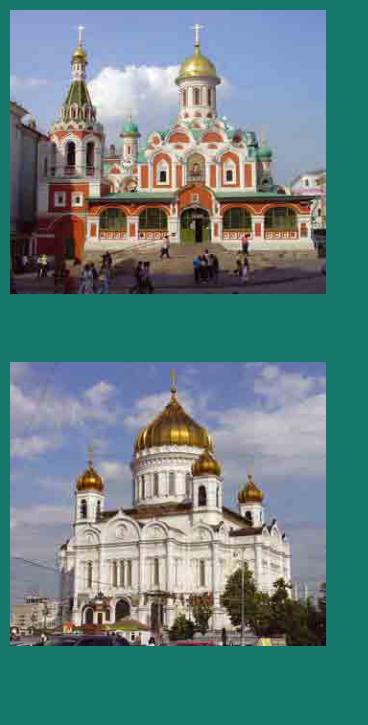
stage – was typified by the campaign in the late 1980s and 1990s for the reconstruction of monuments that had been lost, a campaign that lingers in the memory in the words of vociferous appeals for a renaissance of the Russian historical heritage. The objective significance of this stage was determined by the unprecedented destruction of important architectural monuments and Orthodox sacred places during the Soviet period. Beginning in the early 1990s, many outstanding Moscow buildings of symbolic significance from the 17th to 19th centuries, destroyed in the late 1920s-1930s, were rebuilt anew. These included the Cathedral of Our Lady of Kazan (Fig. 6) and the Gates of the Resurrection on Red Square as well as the Cathedral of Christ the Saviour (Fig. 7) by Konstantin Thon (1837-1883), which was blown up in 1931 and rebuilt in 1995-2002 – the largest cathedral in Moscow at more than 100m. high. The reconstruction work carried out in 1996-1999 on the St. Andrei and St. Alexander Halls of the Great Kremlin Palace, also by Thon (1839-1849), culminated in the installation of the throne of the Tsar. All of these measures, which became symbols of the new Russian history, were carried out under the patronage of the authorities and completed in time periods that would have been extremely short for such restoration work in Europe. The romantic component of the process was intimately interwoven with questions of ideology and politics. The value of the structures that were built – as reference points to historical space – was substantial. They achieved at last a partial restoration of a historical unity in the panoramic views and silhouettes of the centre of Moscow, which had been distorted during the former period. The Cathedral of Christ the Saviour has crowned the perspectives of many streets and skyline, and has become visually and spiritually dominant in the city.
However, certain parameters of these structures (within scientific conservation treatment) turned out to be imprecise and marked by elements of a hypothetical character. Construction materials alien to the historical structures were used (for instance, the reinforced concrete frameworks in the Cathedral of Christ the Saviour and the Kremlin Halls). The tendency towards “mutation” characteristics (in overall dimensions, heights, texture of materials) appeared for the first time, when the necessity for quick results began to predominate over the quality of strict reproduction. So, in the case of the Cathedral of Christ the Saviour, the structure has been set upon a raised ground floor that altered its proportions; several new underground stories which never existed before have appeared beneath it, including an auditorium and garages. Original stone details and sculpture have been reproduced in bronze and plastic.
Fig. 6. The Cathedral of Our Lady of Kazan on Red Square, Moscow, Russia, built in 1620-1636; restored in 1925-1933; destroyed in 1936; reconstructed in 1992-1993 within a World Heritage site (photo author, 2008)
Fig. 7. The Cathedral of Christ the Saviour in Moscow, Russia, built by Konstantin Thon, 1837-1883, destroyed in 1931, reconstructed in 1995-2002 and nominated for the World Heritage Tentative List for Russia in 1996 (photo author, 2008)
Another important point is that the work on the Cathedral of Christ the Saviour – the most ambitious of all the projects – was effectively removed from the professional conservation sphere and handed over to practising architects of general profile. This was the precedent that determined a trend and provided the impetus for the remodelling of the historical heritage on an unprecedented massive scale. As a rule, it is now architects who develop the projects for “reinstitution”
13 Historic reconstruction: prospects for heritage preservation or metamorphoses of theory? |
87 |
|
|
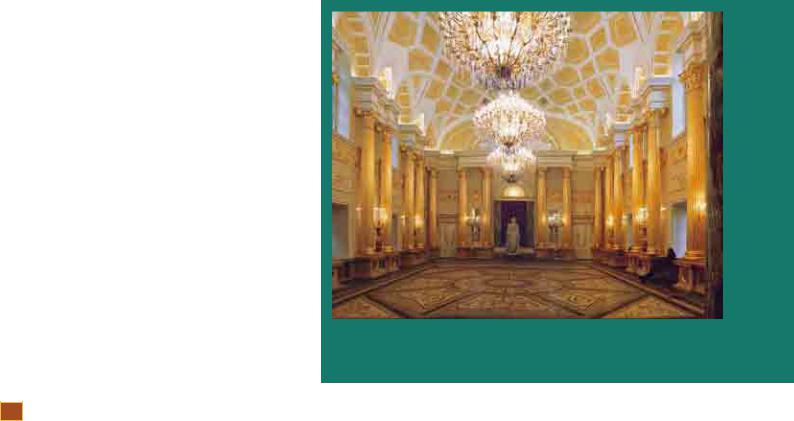
sites (with restorers only involved for discrete elements of the work), and the construction contracts are often awarded not to specialised restoration organisations but to straightforward construction firms. Servile and, as a rule, non-sensitive architects and builders who work quickly and do not possess special scientific conservation knowledge have proved convenient for the realisation of sound projects and ideological programmes. The latest reconstruction of the 18th century Palace of Catherine the Great in Tzaritzino (Moscow, 2008) represents a phantom or, better to say, simulacrum way of creating historical objects, based on hypotheses and an interior design that never existed previously, not even as an architect’s design (Fig. 8). Sensationally, this very project executed by practicing architects has been recently given an award by the Remmers Academy at the Denkmal Leipzig 2008, an international heritage fair functioning under the aegis of UNESCO. In this context the restoration methodology developed over decades has become a mere hindrance. Only the external “historical” form of the building is required, without the complex process of scientific restoration that would ensure the integrity and completeness of the phenomenon that we refer to as culture.
Moscow’s experience in the reconstruction of monuments in the 1990s proved that working within the framework of restoration theory and practice is not only a lengthy process, but also a much more expensive way of doing things than the new construction of historical buildings
- especially since the visible results are similar or even, for the nonprofessional, identical. Another logical conclusion has also been drawn. If an entire stratum of historical heritage could be so easily destroyed in past times and then reconstructed, at least fragmentarily, does this not signify the emergence of a fundamentally new method for the renovation of monuments that is convenient both economically and politically? In other words, is it not simpler, instead of engaging in restoration, to demolish historical structures and then rebuild them in profitable projects with the help of architects using new and durable materials?
So, the Moscow phenomenon of “a new vision of historical heritage” spawned a Trojan horse that advanced deep into the heart of the city, with results that
were not long in making themselves felt. The second reconstruction period, which began in the late 1990s and is still continuing today, has been distinguished by the mass demolition of historic structures and the violation of national legislation (the law of the Russian Federation entitled “On items of the cultural heritage”, 2002). It can justifiably be called barbarous. The scale of the destruction is almost comparable with the damage that was inflicted from the 1930s to the 1960s. In recent years dozens of listed living monuments from the 17th to the 19th centuries and more than three hundred historic buildings have been demolished, as well as entire fragments of city streets and blocks of ordinary housing – from corner to corner. The idea that a city is not a mere aggregation of separate restored buildings, but a unitary structure (the appropriately named “historic fabric of the city”), in which each building forms an inalienable part of the whole, is no longer seen as useful in the modern context. The city’s character and its fabric are being methodically laid waste. Today, in peacetime, the historical capital is being subjected to devastation for the rapid generation of super-profits.
Declaring buildings dilapidated and unsafe condemns to demolition large, robust structures located in the very centre of the city, an extremely attractive area for investment. In 2003-2004 this process led to the destruction of the famous Voentorg department store (1911-1913) from the Art Nouveau period and the Hotel Moskva (1932-1938) close to the Kremlin
88 Conserving the authentic: essays in honour of Jukka Jokilehto
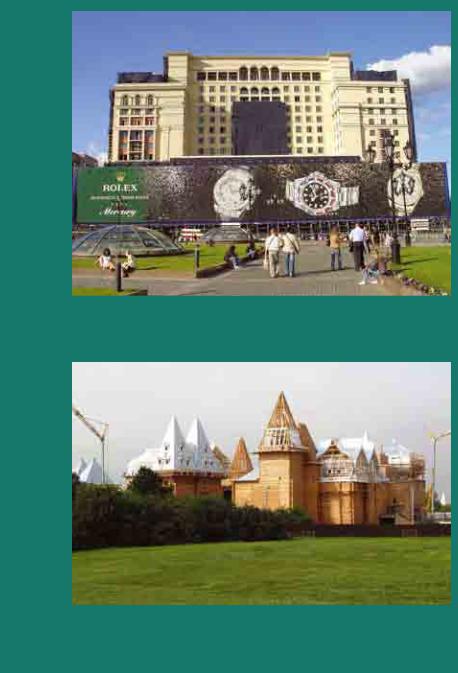
Fig. 9. The Hotel Moskva near the Moscow Kremlin, Russia, built by Alexei Schusev in 1932-1938, demolished in 2004 and under reconstruction since 2006 within a buffer zone of the World Heritage site (photo author, 2009)
Fig. 10. The Palace of the Tsar Alexei Michailovitch in Kolomenskoe, Moscow, Russia, a wooden 17th-century structure dismantled in the second half of the 18th century and currently being re-erected with a concrete skeleton and wooden facades (photo Natalia Samover, 2008)
– a symbol of the 20th century city as a whole (Fig. 9). All structures with wooden floors are also under threat of reconstruction, which as a rule is often a euphemism for demolition. For every one of these buildings plans had been drawn up that involved the construction of multilevel underground space, with the subsequent construction of a copy of the demolished building. Presently the city centre is swamped by the construction of surrogates, pseudo-historical buildings and reproductions. Dozens of clones of historical buildings have appeared, making up entire streets and architectural ensembles. There are even some almost
unbelievable examples of the reinstitution of classical monuments of wooden architecture from the 18th century “in more enduring materials” – brick and reinforced concrete. At the moment, the wooden 17thcentury Palace of the Tsar Alexei Michailovitch in Kolomenskoe, Moscow, dismantled in the second half of the 18th century, is being re-erected with a concrete skeleton and wooden facades (Fig. 10).
A true professional approach, based on definite principles and a clear ideology, has become unnecessary and valueless. This is essentially a process that goes outside ethical restraints. On the one hand, there is no need to conserve, which is to say that the need for costly restoration work no longer exists. At the same time, there is no need to make any intellectual effort and attempt to construct a new building that is equal in quality to the old one or even surpasses it. What we get instead is a reconstruction of what has been just demolished. Of the three possible scenarios following the demolition of a building, the choice has fallen on the worst – which requires the least expenditure in terms of intellectual effort, creative imagination and costs. The growing numbers of such structures glorifying the cult of newness introduce an imbalance into the cultural space of the city, gradually shifting the historical architectural environment outside the range of the concept of heritage and devaluing genuine architectural monuments. Under these conditions, a deformation of consciousness and of professional qualification of both practising architects and restorers is ongoing.
All these facts prove that we are witnessing today not only a specific stage in the history of development of the reconstruction phenomenon that started at the end of the 1980s and has lasted until nowadays. We are talking about the ongoing distortion or, better to say, transformation of the theoretical and scientific principles regarding this field of professional conservation activities.
Reconstruction: definitions and shifts in terminology. Reflections on the international charters and doctrinal texts
As it is generally known from conservation theory, the meaning of the very term “reconstruction” is commonly connected with “building anew”, having in mind the reproduction of a destroyed monument in situ on a precise documentary basis, using old or new materials, and preserving the original forms lost during a war, fire or calamity . Importantly, any type of conjecture or hypothesis is excluded. As a rule,
13 Historic reconstruction: prospects for heritage preservation or metamorphoses of theory? |
89 |
|
|
